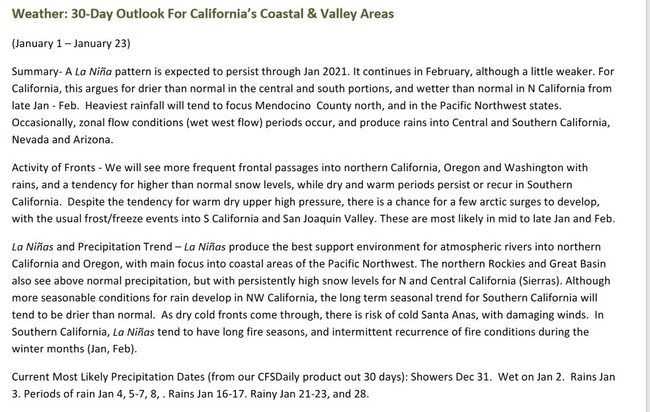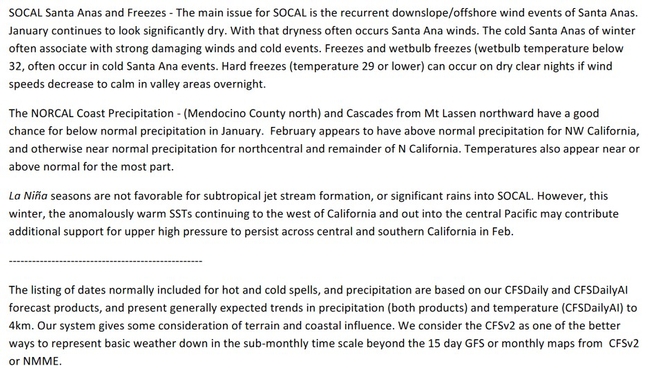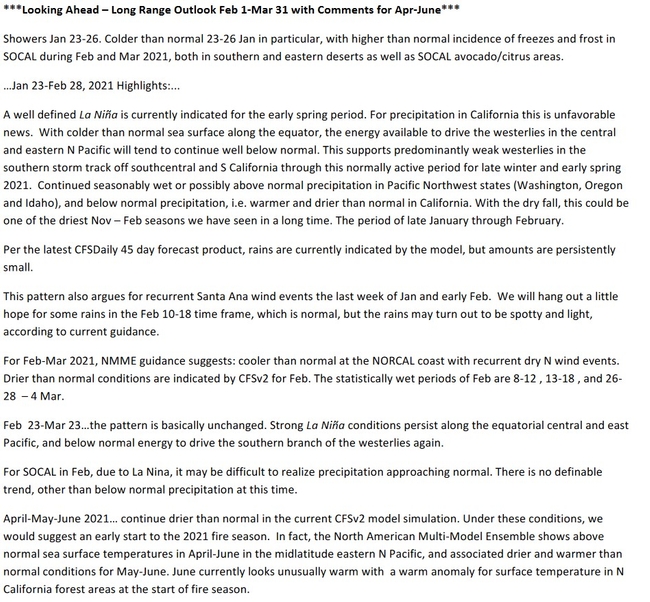
Posts Tagged: weather
It Could Still be a Cold Winter
A moderate La Niña climate phase is expected through spring 2021. This indicates that slightly above average temperatures and slightly less rainfall than normal can be expected in California's avocado/lemon growing areas.
The fact that the winter weather pattern is expected to be warmer than usual doesn't rule out the possibility of a freeze. A freeze can occur any winter, regardless of the climate phase. And dry winters are often susceptible to sudden cold spells because of the lack of tempering effect of soil wet from winter rains
La Niña is one of three climate phases that are part of the El Niño Southern Oscillation (ENSO) climate pattern. Others are El Niño, during which colder and wetter conditions are expected in California, and neutral, when conditions are neither El Niño nor La Niña.
California's most severe freezes have occurred in weak La Niña, weak El Niño or neutral ENSO phases. Severe freezes in Decembers of 1990, 1998, 2001 and 2006 occurred after droughty years and years of low rainfall. In 2015, it snowed in Temecula and again in 2020 – in February!!! So cold weather is still waiting out there.
The most damaging freezes for avocado and citrus are advection and radiation freezes. In advection freezes, cold fronts move arctic air through the region. Radiation freezes feature overnight clear skies and light to no winds with periods of calm. Cold pockets and cold locations will have lower temperatures during radiation freezes. Break freezes and unsettled freezes are the other types of freezes.
During a radiation freeze, cold air drains down and pools in low areas. Know the cold pockets in your grove, and keep that air flowing with a wind machine, if possible.
Read the collected works on frost protection, frost damage and frost recovery here:
https://www.californiaavocadogrowers.com/growing/cultural-management-library/freeze-protection
It's also a good idea to be ready for fires in years of low/no rainfall.
The 2021 Weather Forecast from Fox Weather provided by CAC is below:
Image: Temecula snow on avocados in February
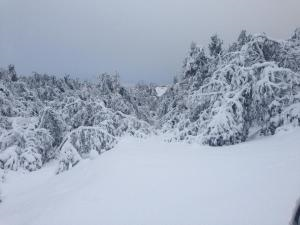
avocado snow Temecula
We Have a Changing Climate
That's what Bob Brendler wrote back in 1988. Bob was the Veg Crops/Strawberry Advisor in Ventura County for 40 years and was a student of the weather. He loved data and was the first in our office to computerize in the 70s. Before he would crank out data on a calculator. Literally, a big old hand crank calculator.. It went to three decimal points.
Here's his article and the results of the study he did on how cold winters had been over time. He looked at the number of days that orchard heaters were "fired" up in order to evaluate the cold for that winter. He showed that winters since 1945 were getting warmer. And they still are.
For years, Terry Schaeffer did frost forecasting for the Ventura area. He knew every cold spot in the county. We don't have that on the ground experience to tell us what to expect now, but there are still some decent forecasts out there for growers.
If you are looking for current frost forecasts, go to the California Citrus Mutual website for the Central Valley, Ventura and Desert forecasts.
https://www.cacitrusmutual.com/industry/weather-watch/
And check out our blog on preparing for winter
https://ucanr.edu/blogs/blogcore/postdetail.cfm?postnum=44155

frost trends ventura
Heat and Trees
Avocados are a semi subtropical tree that can be found in high elevations of cloud forests in Mexico and Central America. A delicious and highly nutritious fruit, the cultivation of avocado has spread around the world. In California, growers are having commercial success in areas with year-round mild climates, such as San Diego, Riverside, Santa Barbara, Ventura and San Luis Obispo counties. Avocados evolved in a very moderate climate and are vulnerable to extreme weather. As a result, they are poorly adapted to the high temperatures and low humidity that can sometimes occur in California, especially in Southern California. In July 2018, there was a historic heatwave that caught everyone off guard, some areas in San Diego reached temperatures of 118-122 °F with winds up to 30 miles per hour. Fortunately, most growers were well into harvesting or just about done during that time, so the 2018 harvest wasn't as impacted as one first thought. Parts further north with later harvests were significantly affected.
Under regular conditions, an avocado tree is extracting water from the soil through its roots, which moves through the tree and exits through leaf pores known as stomates. A stomate is a group of cells in the epidermis made up of guard cells and subsidiary cells. Guard cells are a pair of kidney-shaped cells that form the opening of the stomate. When the guard cells are turgid (full of water), they are open and allow the entry of carbon dioxide for photosynthesis. However, this also exposes the leaf to potential water loss. When the guard cells are flaccid (less water) usually due to high temperature (when temperatures usually rise above 88 °F) and low humidity, this slows the loss of water and to prevent air exchange. The opening and closing of stomates is driven by plant hydration, temperature, relative humidity and wind. The loss of water from a plant's leaves through the stomates acts as an evaporative cooler, maintaining leaf temperature close to that of air temperature. The movement of water through the roots and out the leaves also cools the rest of the tree, preventing the trunk and branches from overheating.
Unfortunately, it seems that heat waves always occur during the peak of the season. Most trees are starting to begin to produce that year's summer flush that will become the following year's bloom which will set to produce the succeeding crop load. Fruit and flowers normally drop if the temperature is 100 °F or above. Thus, the effects of a heatwave can impact several years.
The most sensitive varieties to that heat were the ‘Hass' and ‘Fuerte', whose new leaves shriveled like plastic held to fire. Less affected were the varieties of ‘Sir-Prize' and ‘Sharwil', which had blackening and curling on some new leaves. Some of the toughest were the ‘Pinkerton', ‘Lamb Hass', and ‘Reed'. They showed nearly zero evidence of having been uncomfortable under such a terribly strong sun. Keep in mind, however, that how well any variety of avocado will do under high temperatures is mainly dependent on how well-watered the tree is, in addition to how healthy its root system is overall.
Harvesting
According to Tim Spann from the California Avocado Commission (2018), he suggests that there should be every attempt made to harvest fruit when temperatures are below 90 °F, and no harvesting should take place when temperatures exceed 95 °F. Temperature in the shade should be monitored during harvesting and, when possible, harvesting crews should be moved to the coolest, least exposed areas of the grove. This prevents heat damage to the fruit.
Field bins should be placed under the trees while being filled to protect the harvested fruit from sunburn. Once filled, bins should be moved to a shade structure (open-sided roofed building), or covered with bin covers or light-colored tarps if they cannot be immediately transported to the packinghouse. You should never cover the bins with tree scaffolds or branches, due to the potential spread of Polyphagous Shot hole borer. The insect can potentially hitchhike in the bins and be transported to another grove or the packing house. Also, never leave filled bins exposed to the direct sun. The surface layer of fruit can easily heat up to more than 15 °F above ambient temperature when exposed to direct sun. Acute sunburn will only show on fruit after it is packed and is a major quality detractor. To avoid water loss and decreased fruit quality, do not hold fruit too long after harvest. Transport fruit to the packinghouse at least once per day, if not twice daily (Spann 2018). Bins should not be left in the grove for more than 8 hours after harvest. Cover bins during transport to avoid sunburn and to reduce water loss
Irrigation
Watering enough is absolutely the most important thing you can do to help an avocado tree cope with heat above its comfort zone. Growers should be irrigating their trees in advance of the heat, to ensure that their trees are fully hydrated. An additional 50% of the budgeted amount of water is recommended to be applied the day before a heat wave (Spann 2018). For extended heat waves, daily pulses of irrigation are recommended to maintain the trees' water status and reduce air temperature. A well-watered tree will tolerate the stress of a heat wave much better than a tree that is suffering from water stress.
Cover Crops
Cover crops provide a multitude of benefits based on species selected. Growing cover crops can increase soil organic matter, improve soil structure, enhance nutrient cycling, aid in weed suppression, provide habitat for beneficial insects and pollinators, and build on- farm resiliency to climatic changes (Rowe 2019). For avocado growers in Ventura County, improving water infiltration is a noticeable benefit. All growers that had reported issues of runoff prior to cover cropping have seen dramatic improvements in retaining water in the soil. The ground cover also helps cool the soil and lower air temperature. For a drought prone area and sensitive avocado trees, this could be the difference in surviving a 120 °F heat wave.
Mulch
Avocado roots grow right at the surface of the soil. Mulch keeps that level of the soil comfortably cool and hospitable for avocado roots. The more roots a tree has, the more water it can draw up into its canopy to cool itself. Growers should apply between 3 and 8 inches of organic mulch, such as natural bark chips, straw, or compost, is ideal. Mulch also provides an insolation from sunlight and can reduce air temperatures.
As climate change worsens, it's likely that heat waves and intense droughts in California will become a more common occurrence, placing the long-term future of crops like avocados in jeopardy.
Bibliography
Chalker-Scott, L. The Myth of Hot-Weather Watering “Watering plants on a hot sunny day will scorch their leaves” https://s3.wp.wsu.edu/uploads/sites/403/2015/03/leaf-scorch.pdf. Accessed 11 May 2020.
Downer, J and B. Faber (2019) Mulches for Landscape. UC ANR Publication 8672
Rowe, A. 2019. Panel Explores Avocado Cover Crops. The Grove. Fall 2019. Pp 28-31.
Spann, T. 2018. Avocado Heat Damage Follow-Up. The Grove. Fall 2018. Pp 22-25.
Image: Heat damage to avocado leaves

heat damage to avocado leaves
Heat Forecast - Be Ready
From Fox Weather by way of CA Avocado Commission, hot weather is forecast for mid- to late- June
This is a time to make sure that trees are adequately hydrated prior to the heat spell. Once trees start losing water through transpiration, it's hard for them to absorb water and heat stress and sunburn damage can result. The trees need to be fully water, so that they can continue to transpire to cool themselves during the heat spells.
READ MORE:
https://ucanr.edu/blogs/blogcore/postdetail.cfm?postnum=29992
https://ucanr.edu/blogs/blogcore/postdetail.cfm?postnum=29933
https://ucanr.edu/blogs/blogcore/postdetail.cfm?postnum=27914
And don't forget people in the field:
- Be sure shade is available on demand when the temperature is below 80 degrees F, shade must be provided at all times when the temperature exceeds 80 degrees F, as close as practicable to where employees are working;
- Shade must be provided to all employees on a rest or meal break,except those who choose to take a meal break elsewhere (editor's note: provision of shade as usual may not be consistent with social distancing recommended by various COVID-19 guidance; ag employers implementing heat illness shade requirements can ensure adequate shade consistent with social distancing requirements by staggering meal and rest breaks, but additional shade may be necessary);
- Fresh, pure, and suitably cool water must be made available in sufficient quantities (replenishment is permissible) to allow each employee to drink one quart per hour;
- Water is to be provided as close as practicable to location of work;
- Employees must be trained about heat illness and the Cal/OSHA Heat Illness Prevention (HIP) Standard before they work in conditions where they might be exposed to heat;
- Supervisors must be additionally trained in HIP compliance procedures, emergency responses, and ensuring effective communication to facilitate emergency response.
- A written copy of your HIP program in English and the language understood by the majority of the employees and be available to employees and Cal/OSHA inspectors on request — this is the most frequently-cited part of the HIP standard — and probably the most easily-avoided HIP citation!
- Remember: When temperatures exceed 95 degrees, employers must implement “high heat” procedures, including a mandatory 10 minute break every two hours (meal and rest periods can serve as these breaks, but if employees work beyond eight hours or waive meal or rest periods, you must still ensure the mandatory rest break occurs).
Cal/OSHA Heat Illness Prevention Guidelines
30-Day Weather Outlook for May 31, 2020, to June 22, 2020
Summary- The prevailing pattern is a high pressure ridge from N California westsouthwest or southwestward. Cold fronts coming S through California will tend to extend southwestward from southcentral-S California to the area SW – W of S California.
A long-lived pattern of troughing or low pressure will continue from southwest of Central California to about 25N then extend west toward Hawaii.
The MJO is showing a slow increase in activity over the next two weeks.
CFSDailyAI and CFSv2 suggest some rains primarily in northern California and the Sierras, and into Siskiyou Mountains and southern Oregon at times.
It is early for monsoonal showers and thunderstorms (TSTMS). However, the presence of upper lows may begin to bring tropical moisture northward into SOCAL and the Sierras, despite the lack of a usual summer monsoonal pattern.
Potential Dates of Precipitation (from Fox Weather's CFSDAILYAI system):
Salinas Valley-San Luis Obispo Co- S SierraNV:
Salinas Valley Showers: 6/2-3. Hot spells 6/4, 6/8-9, 6/11-12, 6/14-17, 6/22-27.
San Luis Ob/Edna: Hot spells 6/6, 6/9, 6/12, 6/15-17, 6/20-27th, 7/1.
Southern California Citrus/Avocado Area, San Luis Obispo Co to San Diego Co:
Southern California Citrus/Avocado Area: May 31-June 15.
Santa Barbara, Ventura to San Diego Co: No rainfall of consequence.
Hot spells:
Santa Barbara Co: 6/6, 6/12. 6/16-17th, 6/22-26th.
Ventura Co: Hot 6/16-17th, 6/22-26th.
San Diego/Orange: Hot 6/16-17, 6/22-26.
Summary – June 15 – July 15… In Northern and Central California, Hottest: 6/14-17, 6/22,27, 7/1-2.
San Luis Obispo Co... Hottest periods 6/15-17, 6/22-27.
Southern California… Shallow marine layer and hot inland. Hottest: 6/16-17, 6/22-26, 7/1-3.
Seasonal Outlook July 15 – August 31... Northern and Central California overall pattern…. Near normal rainfall (minimal). Above normal temperatures occur during all of July and all of August. Usual thunderstorms (TSTMS) in the central and N Sierra and Plateau.
Southern California: San Luis Obispo Co, Santa Barbara Co, and Ventura to San Diego Counties east through Los Angeles to San Bernardino, Riverside and Imperial Counties…. Our latest guidance is suggesting a hot period in N and Northcentral California during mid-July, but near normal behavior of the marine layer at the SOCAL coast and valley areas. Although cloud amounts should be about normal, temperatures will drift above normal due to warmer sea surface off SOCAL and Baja. Weak troughs and upper lows will intermittently develop and deepen the marine layer as is normal for summer.
Looking further ahead into Sept – Nov, Dry and persistently warmer than normal conditions develop during the late Sept through Nov Santa Ana season.
Alan Fox...Fox Weather, LLC
Copyright © 2020, Fox Weather, LLC, Used by permission.

heat damage to avocado leaves
Ready! Set! Split! Navel Orange Time.
These are hard days for navel oranges. Drought stress. Salt stress due to drought. Then a heat wave in July that messed the trees up. And now we head into a weird fall with maybe rain. Maybe no rain. Maybe a little rain. This is ripe for navel splitting. This time of year when they are starting to build sugar, they are also ripe for splitting.
Years of drought, and a stressed tree are a perfect set up for navel oranges and fruit splitting.
The days have turned cooler and suddenly out of nowhere there is rain. That wonderful stuff comes down and all seems right with the world, but then you notice the navel fruit are splitting. Rats! No, a dehydrated fruit that has taken on more water than its skin can take in and the fruit splits. This is called an abiotic disease. Not really a disease but a problem brought on by environmental conditions.
Fruit splitting is a long-standing problem in most areas where navel oranges are grown. In some years, the number of split fruit is high; in other years it is low. Splitting in navel oranges usually occurs on green fruit between September and November. In some years, splitting may also occur in Valencia oranges but it is less of a problem than in navel oranges.
Several factors contribute to fruit splitting. Studies indicate that changes in weather including temperature, relative humidity and wind may have more effect on fruit splitting than anything else. The amount of water in a citrus tree changes due to weather conditions and this causes the fruit to shrink and swell as water is lost or gained. If the water content changes too much or too rapidly the rind may split. In navel oranges the split usually occurs near the navel, which is a weak point in the rind.
Proper irrigation and other cultural practices can help reduce fruit splitting. Maintaining adequate but not excessive soil moisture is very important. A large area of soil around a tree should be watered since roots normally grow somewhat beyond the edge of the canopy. Wet the soil to a depth of at least 2 feet then allow it to become somewhat dry in the top few inches before irrigating again. Applying a layer of coarse organic mulch under a tree beginning at least a foot from the trunk can help conserve soil moisture and encourage feeder roots to grow closer to the surface.
If trees are fertilized, apply the correct amount of plant food and water thoroughly after it is applied. If the soil is dry, first irrigate, then apply fertilizer and irrigate again.
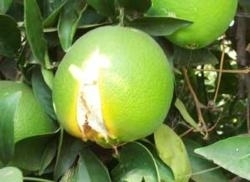
navel split

